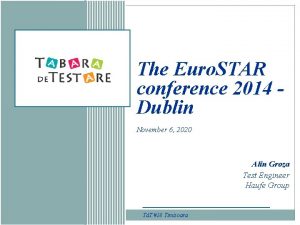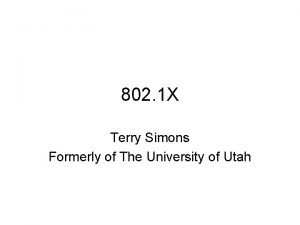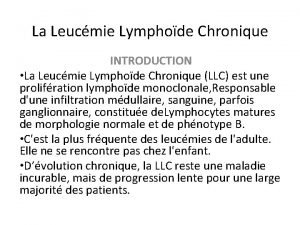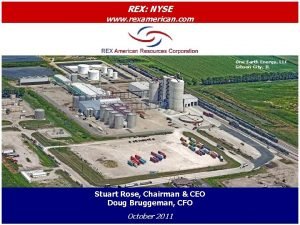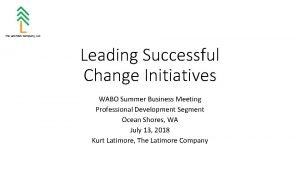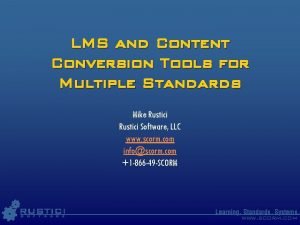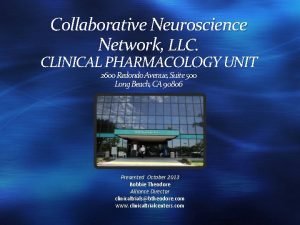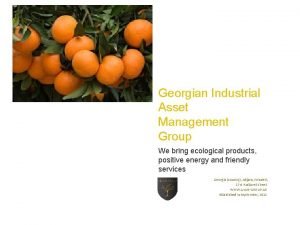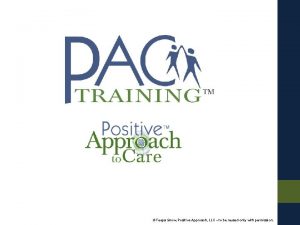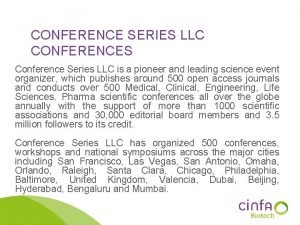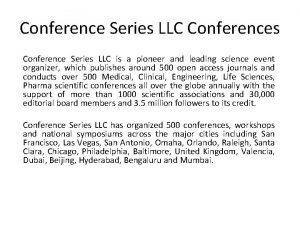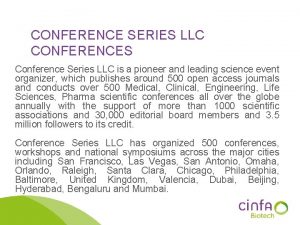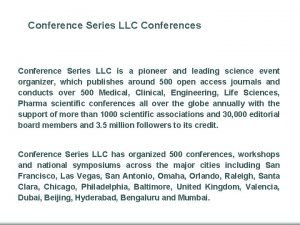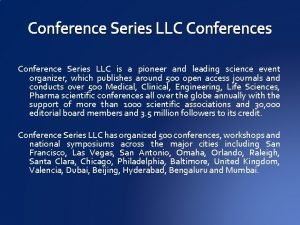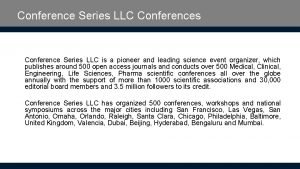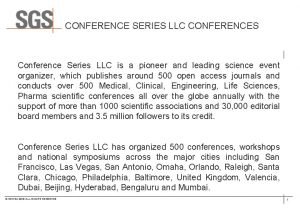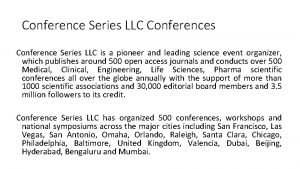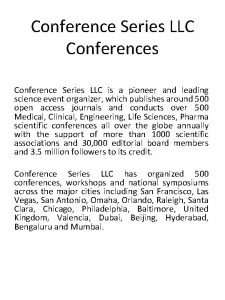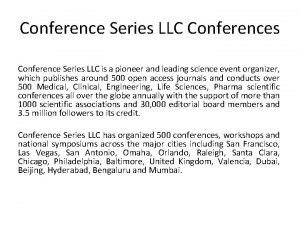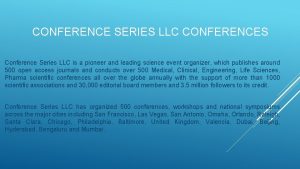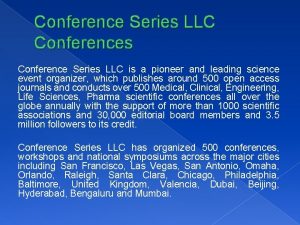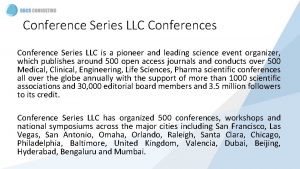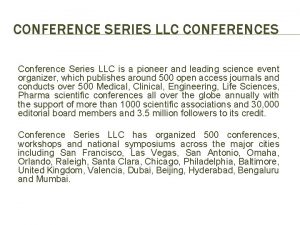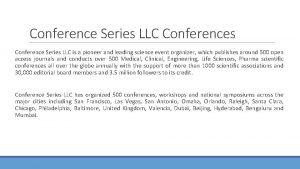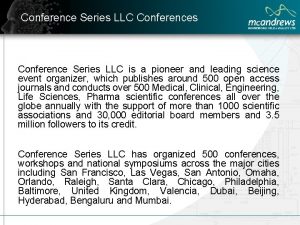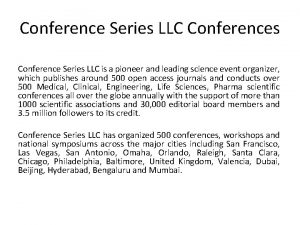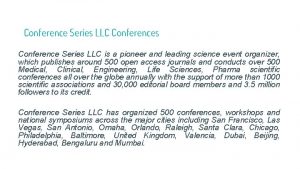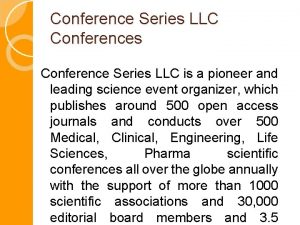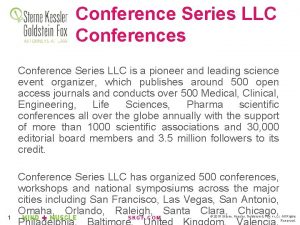Conference Series LLC Conferences Conference Series LLC is















































- Slides: 47

Conference Series LLC Conferences Conference Series LLC is a pioneer and leading science event organizer, which publishes around 500 open access journals and conducts over 500 Medical, Clinical, Engineering, Life Sciences, Pharma scientific conferences all over the globe annually with the support of more than 1000 scientific associations and 30, 000 editorial board members and 3. 5 million followers to its credit. Conference Series LLC has organized 500 conferences, workshops and national symposiums across the major cities including San Francisco, Las Vegas, San Antonio, Omaha, Orlando, Raleigh, Santa Clara, Chicago, Philadelphia, Baltimore, United Kingdom, Valencia, Dubai, Beijing, Hyderabad, Bengaluru and Mumbai.

Growth Potential of Biosimilar Products in Bangladesh Md. Abu Zafor Sadek, M. Pharm, MBA Doctor of Business Administration Candidate IBA, University of Dhaka, Bangladesh & Senior Additional Manager, Renata Limited 5 th Int’l European Biosimilars Congress. 27 -29 June 2016, Valencia, Spain

Contents 1. Changes in Disease Pattern 2. Market Trend of Biological Products 3. Health Budget & Expense 4. Scope of Biosimilar Products 5. At a glance Economic Status of Bangladesh 6. Pharmaceutical Buying Pattern in Bangladesh

Contents 7. A Snapshot on Pharma Industry of Bangladesh 8. Changes in Healthcare Sector of Bangladesh 9. Present Status of Biological Products in Bangladesh 10. Why Bangladesh is Preferable for Biosimilars 11. Selected Articles of Drug Policies of Bangladesh 12. Preferable Mode of Entry for Multinational Companies

Changes in Disease Pattern

Changes in Disease Pattern (Cont’d) In 2010 there were 10% old people (60 yrs) but in 2050 this figure will be increased by 21%. Therefore, chronic care diseases like § Asthma, Alzheimer’s § Bone Density § Hypertension § Cancer & Diabetes are becoming the major health concern. Ref. pwc, 2012 & Where is the Pharmacy to the world & Working Paper on Pharmacy (09 -118), Harvard Business School

Changes in Disease Pattern (Cont’d) The urban population in developing countries is projected to increase from 2. 3 bln in 2005 to 4 bln by 2030. This group are vulnerable to climate change effects especially stroke, Diabetes & cancer. % Urban Ref. The Lancet, 2009

Changes in Disease Pattern (Cont’d) Five NCDs (cardiovascular, cancers, diabetes, obesity & chronic respiratory) factors are the world’s leading causes of death They kill an estimated 35 mln people each year-60% of all deaths globallywith 80% in low and middle income countries. WHO estimates that total deaths from non-communicable diseases will increase by a further 17% over the next 10 years. Ref. Non-Communicable Diseases (2016), World Media Association, Inc.

Biological Products

No. of New Biologics Approved (FDA) in Different Years Ref. USFDA

Biologicals in Pharmaceuticals ü By 2016, 11 out of the top 20 pharma products will be biologics ü By 2020, Biologics will enjoy 28% of global pharma sales ü In last 5 yrs 60 biologic products has been approved globally ü 600 new biologic generics are in development stage Ref. Deloitte, 2016 & Moklesur, 2104

Market Segments (%) of Biologics Ref. IMS MIDAS, Q 2, 2014; Rx

Market Trend of Biologics ü In 2014 the total biologic product market was 288 bln USD ü This market will continue to grow at >10% for next few yrs ü In 2018 the revenue forecast for biological products is 407 bln USD Ref. Industry Overview 2012 & Mokhlesur 2014

Health Budget & Expenses

% of GDP Health Expenditure as % of GDP in selected EU Countries Ref. Data bank of The World Bank

% of GDP Health Expenditure as % of GDP in selected PE Countries Ref. Data bank of The World Bank

Region-wise Pharma Spending as % of Global Total EU 5 Phar merg ing USA 2006 2011 Ref. IMS Health Market Prognosis, 2012 2016

Expense by Developed & Developing Countries 1. Some developed countries are downsizing their health budget 2. Many emerging countries are making the healthcare as priority 3. Due to reduced heath budget some developed countries are becoming price sensitive 4. Due to increased health budget many people from emerging countries will get access to costly treatment if the price is reasonable for them

Biosimilars

Definition of Biosimilars ü Biological Products highly similar to a US licensed reference ü Standing minor difference in clinically inactive component ü No difference in terms of safety, purity & Potency ü Biological Medicinal products ü Contains a version of authorized original medicine ü Demonstrates similarity to the reference product in terms of quality characteristics, biological activity, safety & efficacy ü A biotherapeutic product ü Similar to a licensed product in terms of quality, efficacy & safety

Sl # 1 2 3 4 5 6 7 8 9 10 11 12 13 14 15 Brand Humira Lantus Rituxan Enbrel Remicade Avastin Herceptin Avonex Copaxone Neulasta Lucentis Levemir Novo. Mix 30 Xolair Erbitux Active Adalimumab Insulin Glargine Rituximab Etanercept Infliximab Bevacizumab Trastuzumab Interferon Beta-1 A Glatiramer Acetate Pegfilgrastim Ranibizumab Insulin Detemir Insulin Aspart Omalizumab Cetuximab Total Major Indication Rheumatoid Arthritis Diabetes Rheumatoid Arthritis Crohn’s Disease Ovarian Cancer Breast Cancer Multiple Sclerosis Neutropenia Macular Degeneration Diabetes Allergic Asthma Colorectal Cancer Mkt in $ Bln 10. 8 9. 2 8. 6 8. 3 7. 9 7. 0 6. 8 5. 5 4. 6 4. 5 2. 5 1. 8 0. 25 83. 05 Ref. IMS MIDAS, 06/2014, Rx bound, IMS Patent Focus & The Author Scope for Biosimilars Due to Patent Expiration

Biosimilars Under Development Against Top 05 Brands Total = 111 Ref. The Potential for Biosimilars, IMS Health, March 2016

Region-wise Biosimilars Under Development

Strategic Locations for Biosimilars Global biosimilars market is dominated by Europe, followed by Asia. Pacific, Rest of the World and North America. However, the Asia-Pacific is likely to witness the highest growth due to ü Increase in health infrastructure ü Relaxed regulatory requirements ü Lower labor cost Ref. Markets & Markets, 2016

Reduction of Health Cost (bln USD) in EU 5 & US due to Biosimilars Consideration: 20%, 30% & 40% price reduction of 8 most popular drugs EU 5 : UK, Germany, Italy, France, Spain Ref. The Potential for Biosimilars, IMS Health, March 2016

Bangladesh

Readymade Garments Shrimp Ship Building Tea

At a glance Bangladesh Total Area : 147, 570 km 2 (94 th ) Population : 162 mln (8 th) Density : 1, 033/km 2 (12 th) GDP (PPP) : 572. 44 bln USD (34 th ) GDP (per capita) : 3, 581 USD (144 th ) GDP (nominal) : 205. 32 bln USD (44 th ) GDP (per capita) : 1466 USD (155 th ) Recently the country has been uplifted as lower middle income country from lower income country (Ref. http: //data. worldbank. org) Ref. Bangladesh Bureau of Statistics, 2016 & Index Mundi

GDP Growth % of Bangladesh 7. 2 Ref. Trading Economics (www. tradingeconomics. com/bangladesh/gdp-growth)

Economic Growth of Bangladesh is classified among the Next Eleven emerging market economies in the world. According to IMF, Bangladesh's economy is the 2 nd fastest growing economy of 2016. Bangladesh has seen a major surge in export as the Bangladesh textile industry, the second largest in the world. Ref. The Dhaka Tribune

Export & Import Scenario of Bangladesh Ref. The Dhaka Tribune

Healthcare Expenditure as % of GDP Ref. Ministry of Finance, Bangladesh

Prevalence of Non-Communicable Diseases (NCDs) ü Bangladesh has been maintaining “ 0 polio status” (since 2006) ü Prevalence of emerging of non-communicable diseases (NCDs) ü More than half of hospital deaths were due to NCDs (2014) Ref. The World Bank Report (www. who. int/countryfocus/cooperation_strategy/ccsbrief_bgd_en. pdf)

No. of Patients with Various NCDs in mln (Approx) Ref. The Author (from multiple sources including official websites of different national health institutes of Bangladesh )

Influential Factors for Pharma Buying Process Motivation & Recognition of need by the patients Patients Attitude Price Consultant Visit by the Patients Prescription by the Consultants Promotion Price Dispensing by the Pharmacists Available Information Quality of the product Reputation of the company Availability Commission Purchase Outcome Ref: The Author (collected from Literature Review)

At a glance Pharma Market Total Market : 1. 4 bln USD (2 bln USD in 2018) Company : 200 (95% local) Avg. Growth : 12. 8% (Last 5 yr) Export : 72 mln USD (107 Countries) Export Growth : 15. 65% (Over last yr) Import : <2% of local demand Ref: Light. Castle Analytics Wing in Industry Dynamics, 2015

Market Size of Biologics (mln USD) Sl # Active Y-12 Y-13 Y-14 Y-15 Y-16 1 Insulin 14. 8 18. 1 18. 2 21. 4 27. 6 2 Interferon 1. 92 1. 83 2. 8 3. 33 3. 85 3 MABs* 1. 83 1. 62 2. 82 3. 33 3. 95 4 Erythropoietin 0. 01 0. 02 0. 37 0. 86 1. 17 5 Filgrastim 0. 07 0. 08 0. 09 0. 17 6 Streptokinase 0. 06 0. 07 0. 14 0. 08 0. 15 7 Others 0. 01 0. 04 0. 08 Total 18. 70 21. 73 24. 46 29. 14 36. 97 * MABs: Trastuzumab, Rituximab, Tocilizumab, Bevacizumab Ref: IMS 1 Q, 2016 & Internal Data

Market Trend (approx) of Biotech Products (mln USD) Ref: The Author

Market Share (%) of Biotech Products Ref: IMS 1 Q, 2016 & Internal Data

Growth % Biotech Products Vs Total Pharma Mkt Ref: IMS 1 Q, 2016 & Internal Data

Why Bangladesh (Continued) 1. Huge number of population (Life Exp : 70. 65 years) 2. Decreasing trend of poverty (1. 8% annually) 3. Stable economic growth (Avg GDP Growth : 6 -7%) 4. Increasing health awareness (Education & NGOs)

Why Bangladesh (Continued) 5. Prevalence of non-communicable diseases (Half of total) 6. Geographic location (02 Sea Ports & land connection) 7. Skilled Manpower (Producing Hormones, Vaccines) 8. High Productivity (Laborers, Managers & Entrepreneurs)

Why Bangladesh (Continued) Sl Cost Heads Unit Dhaka Shanghai New Delhi Seoul 1 Worker Wage Person/Month 50 -100 200 -250 150 -180 890 -1275 2 Managerial Staff Person/Month 331 1000 -1500 800 -1200 1900 -2000 3 Industrial Land Per Sqr m 4 Office Rent Sqr. m/month 5 Electricity Per KWh 1000 -1500 5000 -5500 10000 -10500 10 -12 60 -65 30 -35 34. 5 0. 06 -0. 10 0. 1 0. 04 6 Water for Business Use Per Cu. M 0. 25 -0. 33 0. 32 0. 25 0. 62 -0. 98 7 Gas for Business Use Per Cu. M 0. 085 0. 52 0. 29 10 -25% 5 -45% 10 -30% 40% 8 Personal Income Tax Basic Rate * Figures are in USD Ref: Bangladesh Board of Investment (BOI), www. globalpropertyguide. com & The Shanghai daily

Why Bangladesh 9. Advantages of TRIPs (Exempt up to 2032) 10. Government patronization (1982 Drug Ordinance) 11. Investment friendly environment (Govt. Patronization) 12. Success history of pharma export (08 yrs Avg Gr 14%) (Some companies are setting up plants in Saudi Arabia, UAE, Sri Lanka & in some African Countries. At present 3, 600 Bangladeshi brands are already internationally registered and among them 100 are in regulated market) Ref. Mollick, 2015

National Drug Policies 1. A raw material which is locally manufactured will be given protection by disallowing it to be imported if sufficient quantity is available in the country. 2. No multinational company without their own factory will be allowed to market their products after manufacturing them in other factory in a toll basis. 3. No foreign brands may be imported in Bangladesh if the same or similar 03 products are available/manufactured in Bangladesh.

Mode of Entry Joint Venture is the preferable option for Business Operation. Because- ü Limited research activities by the local companies ü Complying with the national drug policies ü Scope to use local marketing expertise ü Advantages of geographical location ü Advantages of TRIPS ü Risk minimization Thank You

LET US MEET AGAIN. . We welcome you to our future conferences of Conference Series LLC through 6 th International Conference and Exhibition on Biologics and Biosimilars October 19 -21, 2016 Houston, TX, USA http: //biosimilars-biologics. pharmaceuticalconferences. com/europe
 As a result of the yalta and potsdam conferences, ________.
As a result of the yalta and potsdam conferences, ________. Meetings incentives conferences and exhibitions (mice)
Meetings incentives conferences and exhibitions (mice) Who attended all three round table conference
Who attended all three round table conference Organising a seminar
Organising a seminar Star conferences inc
Star conferences inc Taylor vs maclaurin
Taylor vs maclaurin Sum of infinite series formula
Sum of infinite series formula Maclaurin series vs taylor series
Maclaurin series vs taylor series P series server
P series server Balmer series lyman series
Balmer series lyman series Series series feedback amplifier examples
Series series feedback amplifier examples Taylor vs maclaurin
Taylor vs maclaurin Series aiding and series opposing
Series aiding and series opposing Horner apg llc
Horner apg llc Elite dna therapy services llc
Elite dna therapy services llc Terry geo doc download
Terry geo doc download Critères nci llc
Critères nci llc Sekisui slec
Sekisui slec Louis rosenfeld information architecture
Louis rosenfeld information architecture Neffs canyon cave
Neffs canyon cave Plankey air llc
Plankey air llc One earth energy llc
One earth energy llc L llc l l l
L llc l l l Speech privacy systems llc
Speech privacy systems llc Www.pekpongpaet.com
Www.pekpongpaet.com 6176503557
6176503557 Rustici software llc
Rustici software llc Llc
Llc 634009
634009 Llc definition
Llc definition Alliance for better care
Alliance for better care Prudent group
Prudent group Gateway travel agent
Gateway travel agent Collaborative neuroscience research llc
Collaborative neuroscience research llc 1o1 pest control, llc
1o1 pest control, llc Hewitt human resources
Hewitt human resources Industrial asset management llc
Industrial asset management llc Llc
Llc Wlaw llc
Wlaw llc American transmission company llc
American transmission company llc Woodfieldpharm steel, llc.usa
Woodfieldpharm steel, llc.usa Positive approach llc
Positive approach llc Peridot solutions
Peridot solutions Iplast russia
Iplast russia Dtelix
Dtelix Exoterra resource llc
Exoterra resource llc Llc
Llc Purosil distributors
Purosil distributors




